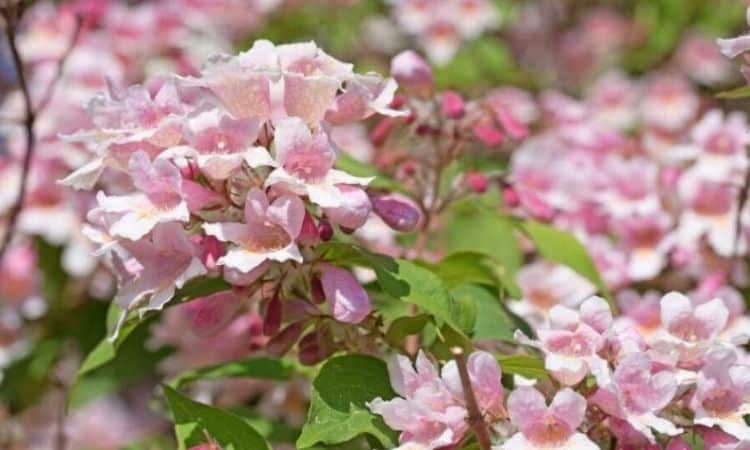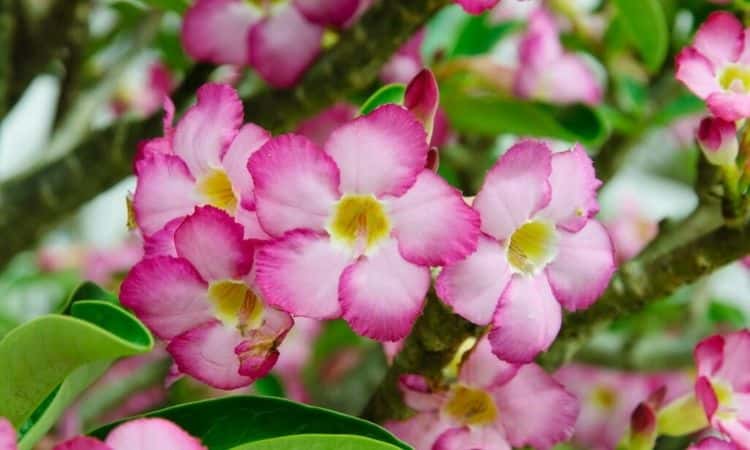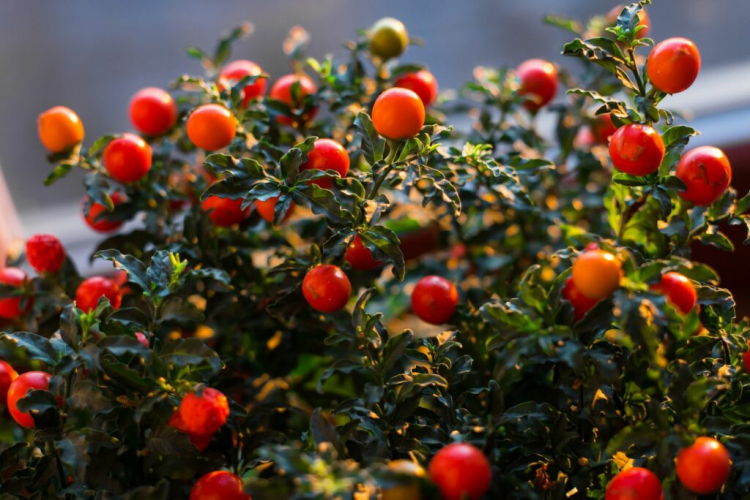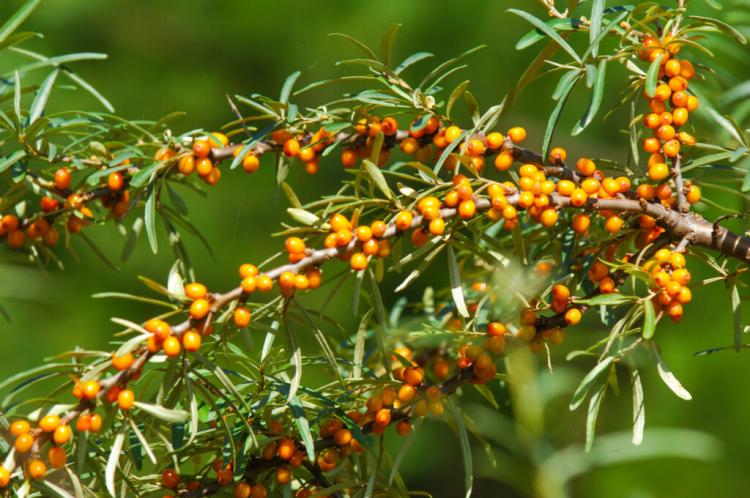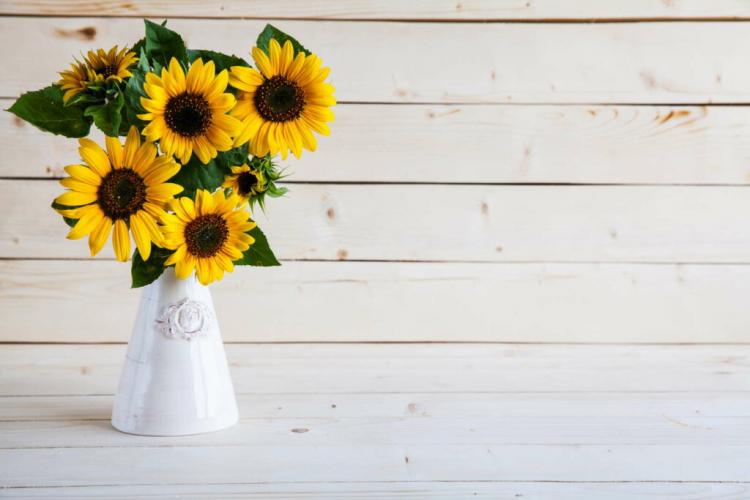Flowering Hedges: 12 Winter Hard Hedge Plants With Flowers
Hedges with blossoms are much more attractive as privacy screens than bare fences and walls. We present the Top 12 hardy flowering hedges for the garden. Those who think of hedges often have the image of accurately cut, green hedge plants in their minds.
No wonder, after all, classics such as the tree of life (Thuja) or false cypress (Chamaecyparis lawsoniana) are still among the most popular hedges today. But if you don’t like the ever-same green hedges, you don’t have to do without the privacy screen altogether: Flowering hedges are a great eye-catcher in the garden.
Especially their changeability, with which they present themselves anew from season to season, offers the variety that many gardeners miss with evergreen hedges. In addition, flowering hedges are also an enrichment for the variety of species in the garden. Thus the flowers often attract numerous beneficial insects, while birds like to use the hedges as a place of retreat. We have summarized our twelve favorite hardy hedge plants with flowers on this list for you.
1. Common Ninebark (The Morton Arboretum)
Table of Contents
If you don’t like boring green hedges, you should definitely check out The Common ninebark (Physocarpus opulifolius). For example, the Common ninebark ‘Diabolo’ is an eye-catcher with blood-red leaves that appear almost black in sunlight.
Especially from May to June the flowering hedge forms a dramatic climax when the cream-white flowers open. Also the red-leaved ‘Diable d’Or’ or the yellow-leaved variety ‘Dart’s Gold’ impress with their flowers and leaf coloration.
The Common ninebark is also particularly popular because of its absolutely easy-care nature: the flowering hedge is not only hardy but also very robust and, with a height of up to three meters, forms a reliable screen in summer.
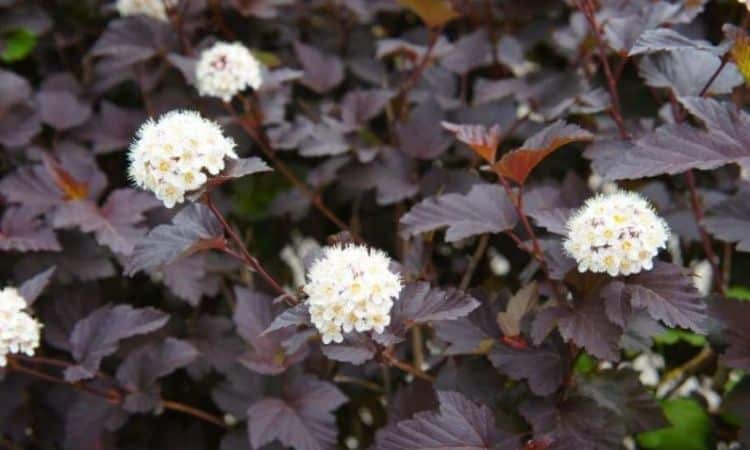
2. Blood Red Currant
Thanks to its robust nature, the Blood Currant (Ribes sanguineum) is particularly suitable for a free-flowering hedge. This means that the plant requires hardly any care except for regular watering. In addition, as a flowering hedge, the Blood Currant is particularly hardy.
Thanks to its dense branching and a growth height of up to two meters, the plant is also suitable as a privacy screen. The pretty red flowers of the plant appear from April to May and not only attract all eyes but also insects.
As an ornamental form, the blood redcurrant only grows sparsely edible fruits, which have a rather sour taste and are therefore quite unpopular with humans. Birds on the other hand are pleased about the berries and like to use the hedge as a food source.

3. Box-Leaf Barberry “Nana”
It is probably one of the best-known flowering hedge plants: The box-leaved barberry (Berberis buxifolia ‘Nana’) has become more and more popular, especially recently, because it is considered a good and robust substitute for boxwood.
The barberry is especially suitable for smaller hedges because it is considered to be very hardy and tolerant of pruning. In May, when the evergreen, flowering hedge shows its golden yellow blossoms, it even trumps the boxwood: the blossoms are true insect magnets that attract beneficial insects of all kinds. The spherical, black-blue berries are eaten by birds.
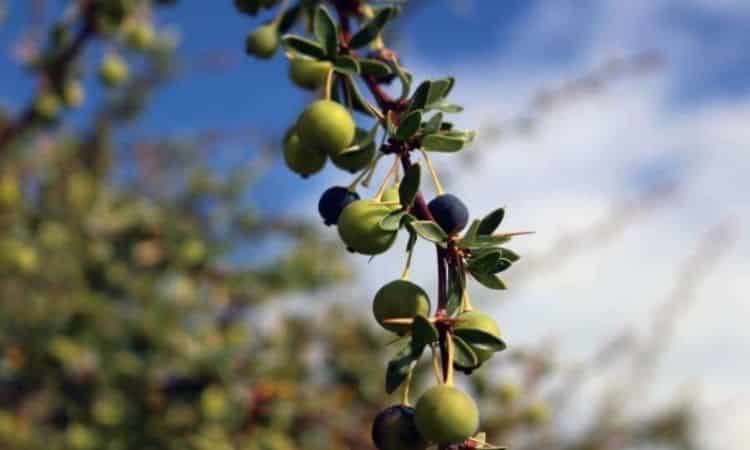
4. Chinese Winter Flowering
A flowering hedge in winter? Actually, this is not a dream, but rather the Chinese Winter Flowering (Chimonanthus praecox). Already in January – in milder winters even before Christmas – the blooming hedge plant shows its full splendor and opens its yellow star-shaped flowers.
The exotic plant is not only a ray of hope for people in winter: if mild temperatures attract beneficial insects from their quarters, they will find a welcome source of food in the Chinese winter flower. With a height of up to three meters and sparse growth, the winter flower is particularly suitable for mixed flowering hedges.
However, it needs winter protection in the first years. However, as soon as the Chinese Winter Flower has established itself as a flowering hedge, it can withstand temperatures down to -10° C without any problems and is therefore considered hardy in most regions USA.
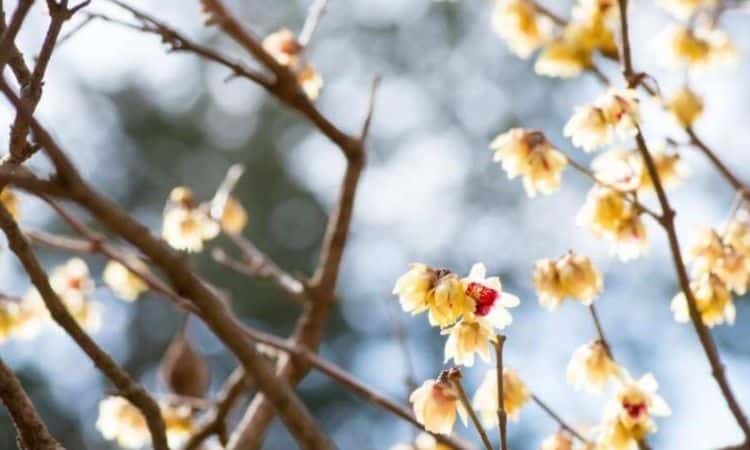
5. Lilac
With its intensive smell, the Lilac (Syringa vulgaris) is a welcome guest in many gardens, which flatters not only the nose. As soon as the shrub shows its blue-violet flowers in May, the plant also turns into a real feast for the eyes. If you are looking for an easy-care flowering hedge, the uncomplicated and hardy Edelflieder is the right choice.
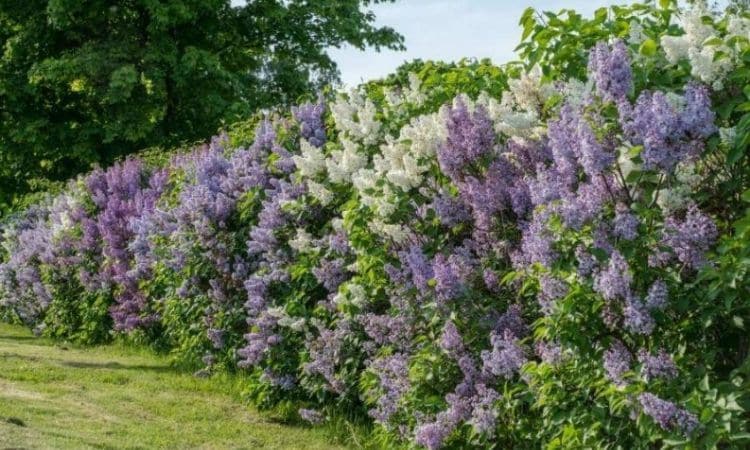
6. Mock Orange
A strong scent of jasmine and an impressive abundance of flowers – no wonder that the Mock Orange (Philadelphus coronarius) is also called false jasmine. Especially the intense scent of the white flowers, which appear from May to June, makes the flowering hedge a popular garden inhabitant.
Beneficial insects also love the Mock Orange – it is not for nothing that it is one of the bee-friendly shrubs. As part of a flowering hedge for privacy protection, the pipe shrub is well suited: in a relatively short time, it can reach impressive heights of up to four meters and looks particularly attractive with its slightly overhanging growth and the dull, deciduous leaves.
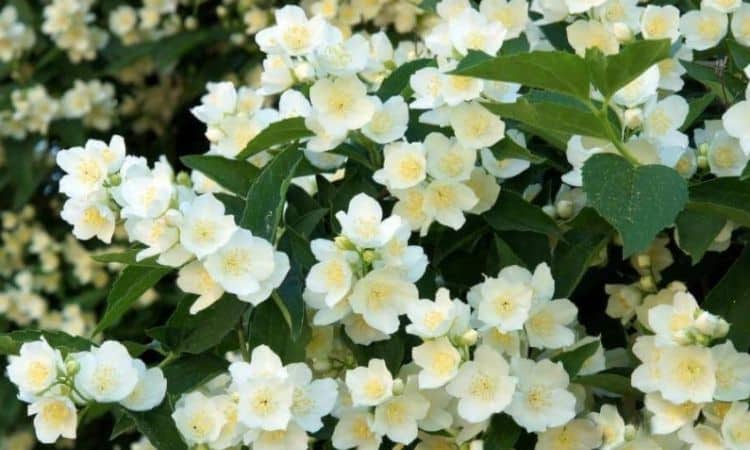
7. Beauty Bush (Linnaea Amabilis)
Between May and June, the Beauty Bush (Linnaea amabilis) impresses with its light pink, slightly shimmering flower. The romantic glow of its pastel-colored flowers even gave the flowering hedge the pretty sobriquet “mother-of-pearl bush”. But the Beauty Bush is not only a treat for the eyes – when the hedge is in bloom, it exudes a pleasant smell in the garden, which also attracts numerous beneficial insects.
Thanks to its rapid growth, which can be around 30 centimeters per year, and its particularly robust nature, the flowering hedge is ideal in summer as a quick and easy-care visual protection. In winter, on the other hand, it is less suitable as a screen, because although the flowering hedge is hardy, it slowly loses its leaves in the fall, after a beautiful fall coloring.

8. Mayflower Shrub
If one wants to talk about flowering hedges, one cannot avoid the mayflower shrub (Deutzia gracilis). As the name already indicates, the mayflower shrub shows a luxuriant pile of star-shaped, small flowers from May to June. During this time, the white-flowering hedge fills the garden with a pleasant sweetish scent, which also attracts numerous bees. With a maximum height of one meter and its robust nature, the deciduous plant is particularly suitable for creating a small, flowering hedge.
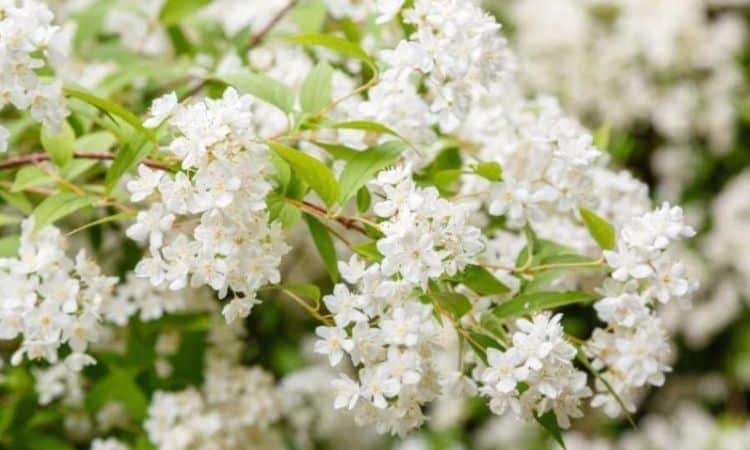
9. Rose
Roses are a must in the garden for many people. However, only a few people know that roses can also be wonderfully integrated as a privacy screen in the garden. Indeed, flowering hedges of wild roses, such as the potato rose (Rosa rugosa) or the sand rose (Rosa mollis) is a great alternative to ordinary hedges. The numerous flowers, whose flowering time can vary greatly depending on the variety, attract not only people but also numerous insects.
In fact, wild roses are a good source of food for all kinds of beneficial insects – in contrast to the widespread cultivated roses, which are often useless for insects because of their double flowers. In late summer, the flowering hedge will additionally delight you with healthy rose hips, which are equally tasty for humans and many bird species.

10. Blackthorn (Prunus Spinosa)
If you do not only value a nice privacy screen but also practical use, you cannot avoid the blackthorn (Prunus spinosa) when choosing your hedge. The blackthorn, as the flowering hedge is also called, impresses from March to April not only with its numerous flowers but is also considered to be extremely insect-friendly.
In addition, the white flowering hedge exudes a pleasant, sweetish smell. From late autumn onwards, edible stone fruits appear on the blackthorn, which can be harvested after the first frost. Humans like especially liqueurs or jams from the herb-aromatic fruits, birds like to steal the berries directly from the tree.
The deciduous blackthorn is particularly popular in near-natural gardens, as it is not only important bee nourishment and bird protection shrub, but also offers reliable privacy thanks to its height of up to 5 meters and dense growth.
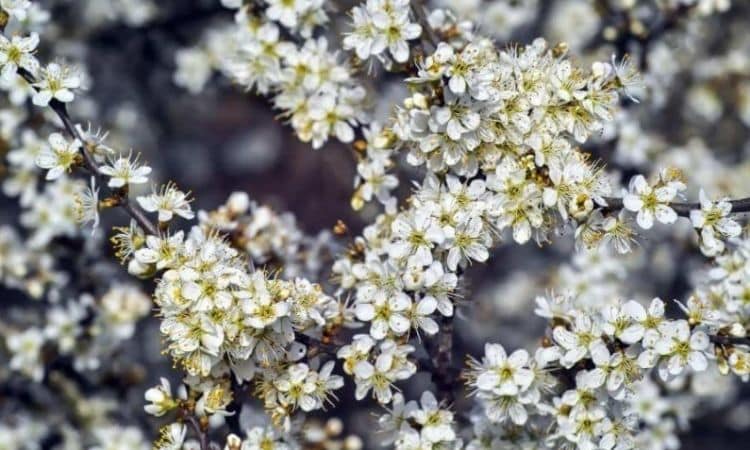
11. Perennial Hibiscus
It is considered a true insider tip among the flowering hedge plants: The perennial hibiscus (Hibiscus moscheutos) impresses from July to October with its huge bell-shaped flowers. The white, pink, or red flowering hedge not only attracts people’s attention but also attracts numerous insects.
Thanks to its bushy growth, the evergreen flowering hedge is perfect as a privacy screen for the balcony and garden. Unlike other hibiscus varieties, it is particularly hardy: an established perennial hibiscus can tolerate temperatures as low as -30° C. Only young plants need light weather protection in winter.
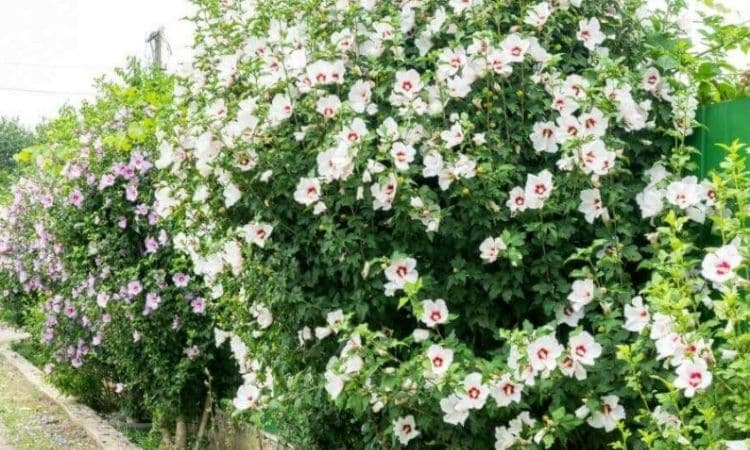
12. Weigela
Hardly any other flowering hedge plant is as popular as the Weigela florida: This indestructible permanent flowering plant is considered particularly easy to care for and is one of the few hedges that bloom almost all year round: From the end of April, the white to pale pink colored flowers open and bloom tirelessly until June.
But even in July and even until the first frost, there are always isolated late blooms. With a height of up to three meters, the Weigela is wonderfully suited as a privacy screen – however, the Weigela must be cut, preferably regularly, otherwise, it tends to grow old.
